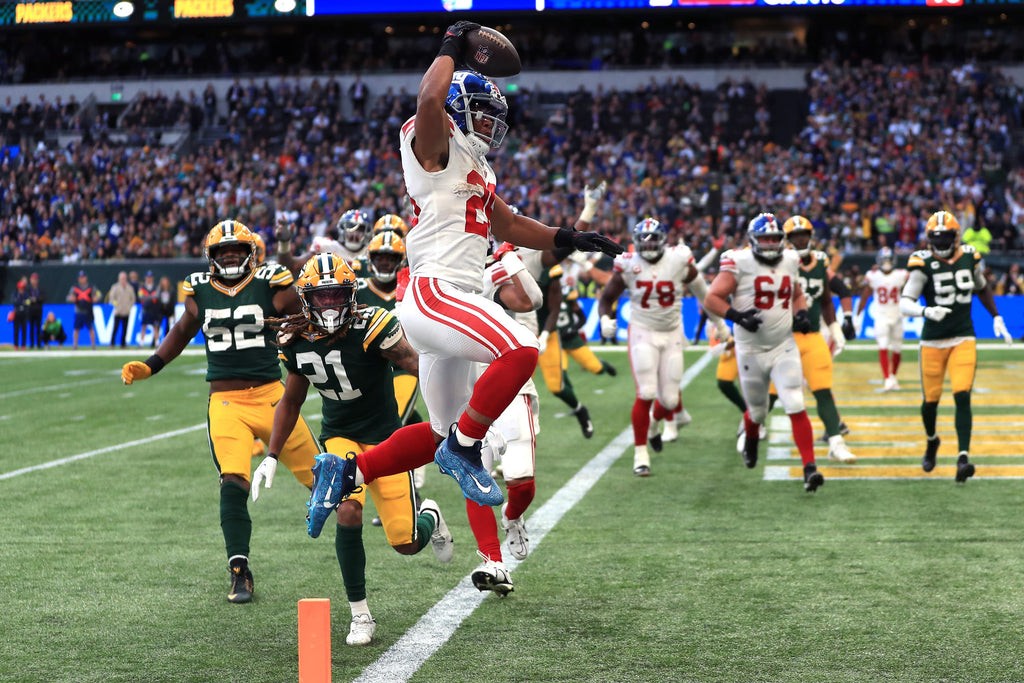American football, a thrilling spectacle combining strategy and athleticism, is a beloved sport attracting fans globally. At CONDUCT.EDU.VN, we offer a detailed breakdown of the game, from its origins to the intricacies of play, enhancing your understanding of football fundamentals and football rules. Dive in to explore football positions, essential football gear, and improve your football knowledge.
1. The Genesis of American Football
American football’s roots trace back to the 19th century, evolving from a blend of rugby and soccer (or “football” as it’s known in many parts of the world). While debates about its direct ancestry continue, the distinct characteristics of American football emerged, including the use of an oval-shaped ball, the strategic combination of passing, running, and kicking, and the establishment of a standard 100-yard field. This unique blend of elements has solidified American football’s place as a prominent and exciting sport.
The sport’s popularity surged, becoming a cultural phenomenon in America. Many athletes hone their skills through school and college teams, aspiring to join professional leagues such as the National Football League (NFL), the pinnacle of American football. The NFL showcases the highest level of competition and talent, attracting millions of viewers each season.
2. The Allure of the NFL: A Spectacle of Sport
American football has cemented itself as a wildly popular sport. The kickoff game of the 2021 NFL regular season saw over 26 million people tuning in to watch! The NFL season is strategically scheduled throughout the week to maximize viewership and engagement.
- Thursday Night Football: A single game kicks off the week, aptly named Thursday Night Football, offering fans a mid-week dose of gridiron action. (For international fans, this typically airs in the very early hours of Friday.)
- Sunday Slate: The bulk of the NFL action unfolds on Sundays, with games strategically staggered throughout the day to provide a continuous stream of entertainment.
- Monday Night Football: Concluding the week’s slate, Monday Night Football provides a primetime matchup to cap off the weekend’s excitement. (Again, very early Tuesday for international audiences).
The rhythm of the NFL season, with its carefully planned game days and strategic scheduling, contributes to its widespread appeal.
3. Deconstructing the NFL Season: From Preseason to Super Bowl
A standard NFL season is divided into distinct phases, each serving a unique purpose in the journey to the Super Bowl.
3.1. The Preseason
The preseason serves as a crucial evaluation period for teams.
- Roster Evaluation: Teams assess their players, particularly backups and rookies, to make informed decisions about roster composition.
- Reduced Exhibition Games: The preseason has been reduced to three exhibition games, focusing on efficiency and minimizing player fatigue.
3.2. The Regular Season
The regular season is where teams establish their records and compete for playoff berths.
- 18-Game Format: The regular season now consists of 18 weeks, including one bye week for each team.
- Bye Week: Teams utilize their bye week for rest, recovery, and strategic preparation.
- Playoff Implications: Regular season records determine playoff eligibility, making each game critical for postseason aspirations.
3.3. The Playoffs
The playoffs showcase the top teams from each conference in a high-stakes, single-elimination tournament.
- Top Seven Teams: The seven teams with the best records from each conference qualify for the playoffs.
- First Round Bye: The team with the best record in each conference receives a first-round bye, providing a significant advantage.
- Wild Card Round: The remaining six teams compete in the Wild Card Round to determine who advances.
- Divisional Round: The winners of the Wild Card Round face off against the top seeds in the Divisional Round.
- Conference Championships: The final four teams battle for their respective conference championships, with the winners advancing to the Super Bowl.
3.4. The Super Bowl
The Super Bowl is the ultimate stage, where the champions of the AFC and NFC clash for the NFL title.
- Global Spectacle: The Super Bowl is a highly anticipated event, attracting a massive global audience.
- Lombardi Trophy: The winning team receives the prestigious Lombardi Trophy, symbolizing their championship victory.
- Championship Rings: Players and staff receive personalized diamond rings, commemorating their Super Bowl triumph.
4. Understanding the Game: Offense vs. Defense
American football is a game of contrasting forces, pitting the offense against the defense in a battle for territory and points.
4.1. The Offensive Arsenal
The offense is responsible for scoring points by advancing the ball down the field.
- Quarterback (QB): The field general, responsible for passing the ball and making crucial decisions.
- Offensive Line (OL): Protects the quarterback and creates running lanes for the running back.
- Running Back (RB): Carries the ball and attempts to gain yardage.
- Tight End (TE): A versatile player who can block and catch passes.
- Wide Receivers (WR): Primarily responsible for catching passes from the quarterback.
The offensive strategy revolves around gaining yards and scoring touchdowns (6 points) or field goals (3 points). After a touchdown, the offense can attempt an extra point kick for one additional point.
4.2. The Defensive Fortress
The defense aims to prevent the offense from scoring and force turnovers.
- Defensive Line (DL): Attempts to pressure the quarterback and stop the run.
- Linebackers (LB): Versatile players who can rush the passer, defend the run, and cover receivers.
- Safeties (S): Deep defenders who provide support against the pass and run.
- Cornerbacks (CB): Cover wide receivers and prevent them from catching passes.
The defensive strategy focuses on stopping the offense from gaining yards and forcing turnovers.
4.3. Gaining Ground: The Down System
The offense must advance the ball at least ten yards in four attempts (downs) to earn a fresh set of downs.
- First Down: The offense starts with a first down and ten yards to gain.
- Subsequent Downs: If the offense fails to gain ten yards, they have subsequent downs (second, third, and fourth) to reach the mark.
- Punting: On fourth down, teams often choose to punt the ball to the opposing team, sacrificing possession to gain better field position.
- Going for It: Teams can also choose to “go for it” on fourth down, attempting to gain the remaining yardage for a first down.
4.4. Turnovers: Shifting Momentum
Turnovers can drastically change the course of a game.
- Interception: When a defensive player catches a pass intended for an offensive player.
- Fumble: When an offensive player loses possession of the ball.
- Safety: When an offensive player is tackled in their own end zone, awarding the defense two points and possession of the ball.
5. Why American Football Captivates Audiences
American football offers a compelling blend of athleticism, strategy, and competition.
- Competitive Balance: Teams are often evenly matched, leading to intense and unpredictable games.
- Strategic Depth: The game involves complex strategies and play-calling, requiring both physical and mental prowess.
- Passionate Fan Base: American football boasts a dedicated and enthusiastic fan base around the world.
6. American Football Glossary
| Term | Definition |
|---|---|
| Holding | An illegal move that involves grabbing and obstructing an opponent. |
| Sack | When the quarterback is tackled behind the line of scrimmage before they can throw a pass. |
| Touchdown | Scoring play worth six points that occurs when a player runs into or catches a pass in the opponent’s end zone. |
| Field Goal | Scoring play worth three points that occurs when the ball is kicked through the uprights. |
| Interception | When a defensive player catches a pass thrown by the opposing quarterback. |
| Fumble | When a player loses possession of the ball while running or being tackled. |
| Punt | A kick used to give possession to the opposing team when the offense fails to gain enough yardage. |
| Blitz | A defensive play where multiple linebackers and defensive backs rush the quarterback. |
| Incomplete Pass | A pass that is not caught by a receiver and falls to the ground. |
| Turnover | Any play where one team loses possession of the ball to the other team. |



7. Essential American Football Rules
| Rule Category | Description |
|---|---|
| Scoring | A touchdown is worth 6 points, a field goal is worth 3 points, a safety is worth 2 points, and an extra point after a touchdown is worth 1 point. |
| Offsides | A penalty that occurs when a player is on the wrong side of the line of scrimmage when the ball is snapped. |
| Pass Interference | A penalty that occurs when a player illegally interferes with an opponent’s ability to catch a pass. |
| Roughing the Passer | A penalty that occurs when a defensive player makes illegal contact with the quarterback after the quarterback has thrown the ball. |
| Holding | A penalty that occurs when a player illegally impedes the movement of an opponent by grasping or hooking them. |
| False Start | A penalty that occurs when an offensive player moves before the ball is snapped. |
| Delay of Game | A penalty that occurs when the offense fails to snap the ball before the play clock expires. |
| Unnecessary Roughness | A penalty that occurs when a player uses excessive or illegal force against an opponent. |
| Facemask | A penalty that occurs when a player grabs the facemask of an opponent. |
| Clipping | A penalty that occurs when a player blocks an opponent from behind below the waist. |
8. The History of the NFL
| Year | Event |
|---|---|
| 1920 | The American Professional Football Association (APFA) is founded. |
| 1922 | The APFA changes its name to the National Football League (NFL). |
| 1933 | The NFL introduces divisional play. |
| 1958 | The Baltimore Colts defeat the New York Giants in “The Greatest Game Ever Played.” |
| 1966 | The first Super Bowl is played between the NFL and AFL champions. |
| 1970 | The NFL and AFL merge into one league. |
| 2002 | The NFL realigns into eight divisions. |
| 2011 | The NFL implements a new collective bargaining agreement with the players. |
| 2021 | The NFL expands the regular season to 17 games. |
9. Common American Football Strategies
| Strategy | Description |
|---|---|
| Run-Heavy Offense | An offensive strategy that focuses on running the ball frequently to control the clock and wear down the defense. |
| Pass-Heavy Offense | An offensive strategy that focuses on passing the ball frequently to gain large chunks of yardage and score quickly. |
| Zone Defense | A defensive strategy where defensive players are assigned to cover specific areas of the field rather than specific players. |
| Man-to-Man Defense | A defensive strategy where defensive players are assigned to cover specific offensive players. |
| Blitzing | A defensive strategy where multiple defensive players rush the quarterback to pressure him into making a mistake. |
| Prevent Defense | A defensive strategy used when a team has a lead late in the game, designed to prevent the opposing team from scoring quickly. |
| Special Teams Focus | A strategy that emphasizes the importance of special teams plays, such as kickoffs, punts, and field goals, to gain an advantage in field position and scoring opportunities. |
| Clock Management | The strategic use of timeouts and play-calling to control the game clock and maximize scoring opportunities. |
10. American Football FAQs
Q1: What is a touchdown in American football?
A touchdown is a scoring play worth six points that occurs when a player runs into or catches a pass in the opponent’s end zone.
Q2: How many players are on an American football team?
There are 11 players on the field for each team at a time, but the total roster size is usually 53 players.
Q3: What is a field goal in American football?
A field goal is a scoring play worth three points that occurs when the ball is kicked through the uprights.
Q4: What is an interception in American football?
An interception is when a defensive player catches a pass thrown by the opposing quarterback.
Q5: What is a fumble in American football?
A fumble is when a player loses possession of the ball while running or being tackled.
Q6: How does the scoring work in American football?
A touchdown is worth 6 points, a field goal is worth 3 points, a safety is worth 2 points, and an extra point after a touchdown is worth 1 point.
Q7: What are the main positions in American football?
The main positions include quarterback, running back, wide receiver, offensive line, defensive line, linebacker, and defensive back.
Q8: What is the importance of special teams in American football?
Special teams are crucial for kickoffs, punts, and field goals, impacting field position and scoring opportunities.
Q9: How is the game started in American football?
The game starts with a kickoff, where one team kicks the ball to the other team to begin the first possession.
Q10: How many downs does a team have to advance the ball?
A team has four downs to advance the ball at least 10 yards to get a new set of downs.
Whether you’re a seasoned enthusiast or new to the sport, understanding the fundamentals of American football enhances your appreciation for its dynamic nature.
Navigating the complexities of rules, standards and compliance can be overwhelming. At CONDUCT.EDU.VN, we understand the challenges in accessing reliable guidelines and standards of conduct. We offer comprehensive resources tailored to various industries and professions, ensuring you have the knowledge to uphold ethical practices.
For detailed guidance and resources, visit conduct.edu.vn. Our team is ready to assist you. Contact us at 100 Ethics Plaza, Guideline City, CA 90210, United States, or reach out via WhatsApp at +1 (707) 555-1234.
